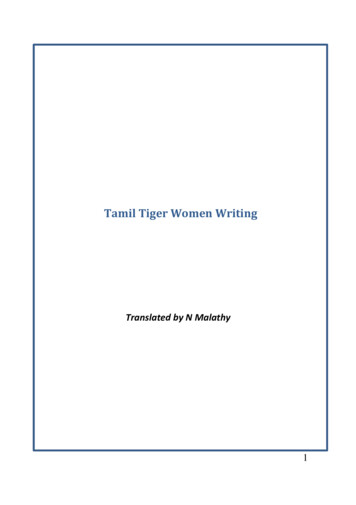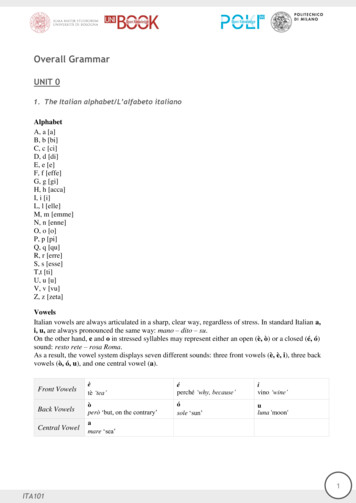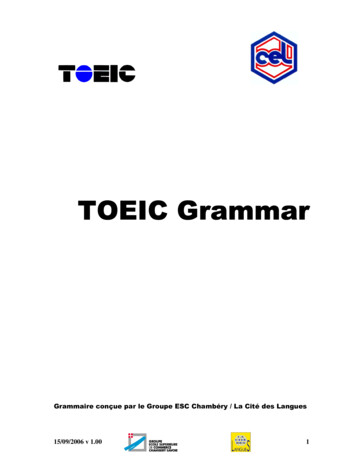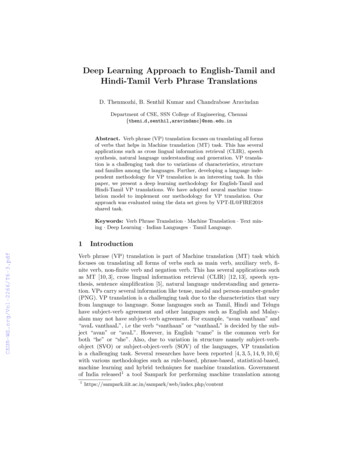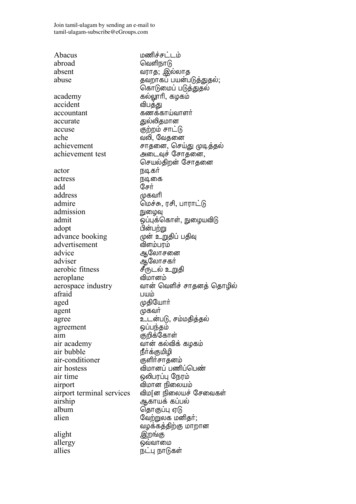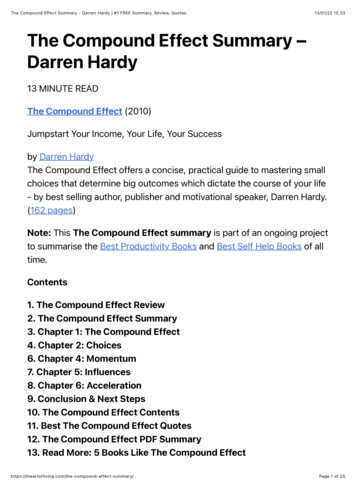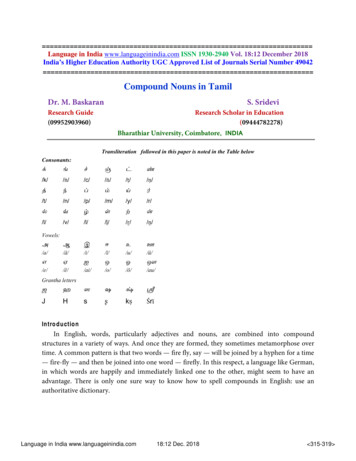
Transcription
Language in India www.languageinindia.com ISSN 1930-2940 Vol. 18:12 December 2018India’s Higher Education Authority UGC Approved List of Journals Serial Number 49042 Compound Nouns in TamilDr. M. BaskaranS. SrideviResearch Guide(09952903960)Research Scholar in Education(09444782278)Bharathiar University, Coimbatore, INDIATransliteration followed in this paper is noted in the Table belowConsonants:‚ƒ„ †‡/k//ṅ//c//ñ//ṭ//ṇ/ˆ‰Š‹Œ /t//n//p//m//y//r/ /å/o/à/u/æ/ö/á/ü/å �/Grantha lettersüýJHIn tro d u ctio nIn English, words, particularly adjectives and nouns, are combined into compoundstructures in a variety of ways. And once they are formed, they sometimes metamorphose overtime. A common pattern is that two words — fire fly, say — will be joined by a hyphen for a time— fire-fly — and then be joined into one word — firefly. In this respect, a language like German,in which words are happily and immediately linked one to the other, might seem to have anadvantage. There is only one sure way to know how to spell compounds in English: use anauthoritative dictionary.Language in India www.languageinindia.com18:12 Dec. 2018 315-319
There are three forms of compound words:the closed form, in which the words are melded together, such as firefly, second hand,softball, childlike, crosstown, redhead, keyboard, makeup, notebook;the hyphenated form, such as daughter-in-law, master-at-arms, over-the-counter, six-pack,six-year-old, mass-produced;and the open form, such as post office, real estate, middle class, full moon, half sister,attorney general.C o n cep t of C om p o u n d w ord in Tam il L an g u ag eThe concept of Compound word is different from that of English. Compound noun (word)is a noun in which more than one word is combined to act as a noun. Normally two words ofwhich the succeeding word is noun. The preceding word may be noun, verb, adjective, or adverb.Traditional grammar view this as /tokainilai ttoṭar/ (ªî èG ôˆ ªî ì ) which means aphrase comprising of two words between which a marker is hidden and implicit. For thepurpose of reference in this Thesis they are labeled as Marker Implicit Phrases abbreviated asMAIM.C o m p o u n d w ord s in Trad itio n al G ram m arTraditional grammarians have identified six / tokainilai ttoṭar/s (ªî èG ôˆ ªî ì èœ) inTamil language. They are:1. /veṟṟumaittokainilai ttoṭar/ («õŸÁ ñˆ ªî èG ôˆ ªî ì ) usually labeled as/veṟṟumaittokai/ («õŸÁ ñˆ ªî è): (MAIMCA – MAMIM Case marker).2. /vinaittokainilai ttoṭar/ (M ùˆ ªî èG ôˆ ªî ì ) usually labeled as /vinai ttokai/(M ùˆªî è): (MAMIMTE – MAMIMTE – MAIM Tense marker).3. /paṇputtokainilai ttoṭar/ (ð‡¹ˆ ªî èG ôˆ ªî ì ) usually labeled as /paṇputtokai/(ð‡¹ˆªî è): (MAMIMQU – MAMIM quality marker).4. /uvamaittokai nilai ttoṭar/ (àõ ñˆ ªî èG ôˆ ªî ì ) usually labeled as/uvamaittokai/ (àõ ñˆªî è):(MAIMSI – MAMIM simile marker)5. /ummaittokai nilai ttoṭar/ (à‹ ñˆ ªî èG ôˆ ªî ì ) usually labeled as/ummaittokai/ (à‹ ñˆ ªî è) (MAIMCO – MAMIM conjunction marker)6. /aṉmoḻi ttokai nilai ttoṭar/ (Ü¡ªñ Nˆ ªî èG ôˆ ªî ì ) usually labeled as /aṉmoḻittokai/ (Ü¡ªñ Nˆ ªî èG ô)Of these the last one is a phrase evolved from any one of the other five and its meaning issyntactically inferred and the morphological structure is like that of the /toṭar/ from which it isevolved.Language in India www.languageinindia.com18:12 Dec. 2018 315-319
The fifth one is a two word in which the conjunction marker suffixes /um/ (à‹) are implicitand hidden not only in the first word but also in the second.For example, /mälai kalai/ (ñ ô è ô)This /um/ has the function of ‘and’. Hence it treated as two separate words and not as singleentity as the other / toṭar/s. Hence /tokainilai ttoṭar/s which are treated as compound are fall underthe following types namely /veṟṟumaittokai/ (MAIMCA) , /vinaittokai/ (MAIMTE) , /paṇputtokai/,and /uvamaittokai/For example the phrase or compound word /püṅkoṭi/ (̃ªè ) in the morphologicalaspect it is /uvamaittokai/ (àõ ñˆªî è-MAIMSI). But the use of /püṅkoṭi/ in the sentence/püṅkoṭi vanṭäļ/ (̃ªè õ‰î œ) , /püṅkoṭi/ means a person with an attribute /püṅkoṭi/. Hence itis labeled /uvamaittokai purṭupiṟanṭa aṉmoḻi ttokai/ (àõ ñˆ ªî èŠ ¹øˆ¶Š Hø‰îÜ¡ªñ Nˆªî è). Such /aṉmoḻi ttokai/s are in use in the language that are the extention of thethe five /tokainilaittoṭar/s namely, /veṟṟumaittokai/ (MAIMCA), /vinaittokai/ (MAIMTE),/paṇputtokai/ (MAIMQU), /uvamaittokai/(MAIMSI), /ummaittokai/(MAIMCO).There is another type of compound word or /toṭar/ called /urupum payaṉum uṭaṉ tokkatokai/.This means that a phrase of two words between which a marker and another word are implicit orhidden to reveal meaningful utterance. This is illustrated with the following description./mälai vaṅkiṉëṉ/ (ñ ô õ ƒA«ù¡) can be expanded as /mälaiai vaṅkiṉëṉ/ (ñ ô òõ ƒA«ù¡). Here the objective case marker /’ai’/ (ஐ) is implied. That is hidden in between thetwo words /mälai/ and /vaṅkiṉëṉ/. Therefore it is /veṟṟumaittokai/ («õŸÁ ñˆ ªî è).In the sentence /pümälai väṅkiṉëṉ/ (Ìñ ô õ éA«ù¡), the compound word /pümälai/ canbe expand not as /pü äl mälai/ (Ì Ý ñ ô) but as / pü äl seyapaṭṭa mälai/ (Ì Ý Ýù ñ ô Ìõ ô ù ñ ô). / äl/ is case marker of ordinal number III. /urupum payaṉumuṭaṉ tokkatokai/s related to other /tokai/s also found in the language.As explained above compound words fall under any one of the following types.1. /veṟṟumaittokai/ (MAIMCA), («õŸÁ ñˆ ªî è)implicit.– phrase in which case marker is2. /vinaittokai/ (MAIMTE), (M ùˆªî è) - phrase in which tense marker is implicit3. /paṇputtokai/(MAIMQU), (ð‡¹ˆªî è)- phrase in which quality marker is implicit4. /uvamaittokai/ (MAIMSI) (àõ ñˆ ªî è) - phrase in which simile marker is implicitLanguage in India www.languageinindia.com18:12 Dec. 2018 315-319
When the case makers 2nd, 3rd, 4th, 5th. 6th, and 8th phrases in which case markers areimplicit, these can be divided into another six types {This is indicated by the number suffix in theabbreviation: Eg. MAIMCA2 means the compound noun in which the case marker ‘ai’ (ஐ). 2ndcase implicit) making the count 9. /urupum payaṉum uṭaṉ tokkatokai/s can be evolve from each ofthese phrases. Hence as such the compound words are of 9 types making the count 18.Further, there is another kind of /tokainilai ttoṭar/ (ªî èG ôˆ ªî ì ) which is labeled as/irupeyaroṭṭup paṇputtokai/ (Þ¼ªðòªó † Š ð‡¹ˆªî è). It is a kind of /paṇputtokai/ which amorphological combination of two nouns, the first is the sub-ordinate of an entity and thesucceeding word is the super ordinate.For example, the compound noun /välaimaram/ (õ öñó‹) consists of two words (nouns)/välai/ (õ ö) and / maram/ (ñó‹) in which /välai/ is sub-ordinate and / maram/ is superordinate. This compound noun is abbreviated as ORIM.C o n so lid ated L istIncluding this category 19 types of compound words/nouns are seen in Tamil Language. Allthese types are generally adopted in poetical works. Any how these are the types of compoundwords considered in this study.Following table lists the labels of all compound words.S. No. Label in ISO transliterationTamil in TamilAbbreviation1./iraṇṭäm veṟṟumaittokai/2Ý‹ «õŸÁ ñˆ ªî èMAIMC22./müṉṟäm veṟṟumaittokai/3Ý‹ «õŸÁ ñˆ ªî èMAIMC33./näṉkäm veṟṟumaittokai/4Ý‹ «õŸÁ ñˆ ªî èMAIMC44./aintäm veṟṟumaittokai/5Ý‹ «õŸÁ ñˆ ªî èMAIMC55./ äṟṉm veṟṟumaittokai/6Ý‹ «õŸÁ ñˆ ªî èMAIMC66./ëḻäm veṟṟumaittokai/7Ý‹ «õŸÁ ñˆ ªî èMAIMC7/2äm veṟṟumai urupum2Ý‹ «õŸÁ ñˆ ªî è༹‹ ðò‹àì¡ªî ‚èˆ ªî èMAIMCA2MAIMCA3payaṉum uṭaṉ tokkatokai/3Ý‹ «õŸÁ ñˆ ªî è༹‹ ðò‹àì¡ªî ‚èˆ ªî è/4äm veṟṟumai urupum4Ý‹ «õŸÁ ñˆ ªî èMAIMCA47payaṉum uṭaṉ tokkatokai/8.9/3äm veṟṟumai urupumLanguage in India www.languageinindia.com18:12 Dec. 2018 315-319
payaṉum uṭaṉ tokkatokai/༹‹ ðò‹àì¡ªî ‚èˆ ªî è/5äm veṟṟumai urupum5Ý‹ «õŸÁ ñˆ ªî è༹‹ ðò‹àì¡ªî ‚èˆ ªî èMAIMCA56Ý‹ «õŸÁ ñˆ ªî è༹‹ ðò‹àì¡ªî ‚èˆ ªî èMAIMCA6MAIMCA7payaṉum uṭaṉ tokkatokai/7Ý‹ «õŸÁ ñˆ ªî è༹‹ ðò‹àì¡ªî ‚èˆ ªî è13/vinaittokai/M ùˆ ªî èMAIMTE,14/ vinaiurupum payaṉumM ù ༹‹ ðò‹àì¡ªî ‚èˆ ªî èMAIMTEAMAIMQU10payaṉum uṭaṉ tokkatokai/11/6äm veṟṟumai urupumpayaṉum uṭaṉ tokkatokai/12/7äm veṟṟumai urupumuṭaṉ tokkatokai/15/paṇputtokai/ð‡¹ˆ ªî è16/paṇpu urupum payaṉumð‡¹ à¼¹‹ ðò‹àì¡ªî ‚èˆ ªî èuṭaṉ tokkatokai/17/uvamaittokai/18/uvamai urupum payaṉumuṭaṉ tokkatokai/19àõ ñˆ ªî èàõ ñ ༹‹ ðò‹àì¡ªî ‚èˆ ªî è/irupeyaroṭṭup paṇputtokai/ Þ¼ªðòªó † Šð‡¹ˆªî èÞ¼ªðòªó † Šð‡¹ˆªî èMAIMQUAMAIMSIMAIMSIAORIMC o n clu sio nThe concept of Compound word in Tamil is linguistically same as that of English. Butmorphologically it is different. This is a separate linguistic entity in which either of case, tense,quality, simile, or conjunction is implicit between two words. It is named as /tokainilaittoṭar/ªî ì ). Among /tokainilaittoṭar/s, /aṉmoḻittokai nilaittoṭar/ (Ü¡ªñ Nˆ(ªî èG ôˆªî èG ô) is not a morphological entity. It is a syntactic entity whose meaning is inferredmorphological pattern. Hence it is included in the other types of compound words. Inferring inthis approach Compound nouns are classified into 19 types which are tabulated in the previoussection.Language in India www.languageinindia.com18:12 Dec. 2018 315-319
Concept of Compound word in Tamil Language . The concept of Compound word is different from that of English. Compound noun (word) is a noun in which more than one word is combined to act as a noun. Normally two words of which the succeeding word is noun. The preceding word may be noun, verb, adjective, or adverb.

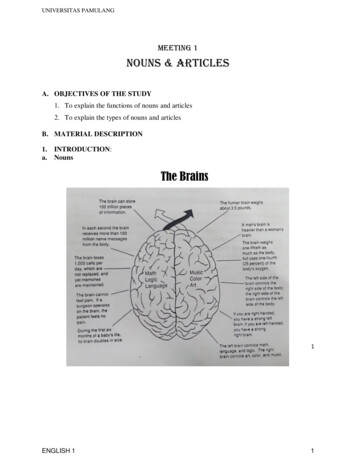
![Tamil Computer Magazine Free [WORK] Pdf](/img/63/tamil-computer-magazine-free-download-pdf.jpg)
![Tamil Ilakkiya Varalaru In Tamil Pdf Free [PORTABLE] - Jbr Films](/img/63/wenslato.jpg)

